The increasing reliance of Irish livestock enterprises on imported feed was attracting more attention long before the recent escalation in concentrate costs and concerns surrounding feed availability.
New initiatives introduced by the Department of Agriculture via the Tillage Incentive Scheme, multispecies/red clover sward measures and tweaks to the Protein Aid Scheme are aimed at increasing the volume of fodder grown on farms this season.
John Fraser’s farm in Garrons, a short distance outside Stradbally in Co Laois, has been striving in recent years to develop a more holistic system where the enterprises of beef, sheep and tillage deliver mutual benefits.
The farm was traditionally predominately tillage, along with finishing some continental cattle.
However, since taking over the running of the farm, John has developed a sheep enterprise which has grown to in excess of 300 head and a dairy calf-to-beef enterprise, which now numbers 90 to 100 head.
Self-sufficiency focus
The focus on the farm is to drive production where at all possible from feed grown on the farm or in close proximity in the case of the purchase of fodder beet and grazing of catch crops grown by neighbouring farmers.
The livestock enterprises also have to dovetail with each other in terms of making best use of available facilities.
The flock of 250 mature ewes are mated to lamb in a tight three- to four-week timeframe in February. Once ewes vacate straw-bedded sheds they are cleaned, washed and disinfected in advance of calves being purchased in March.
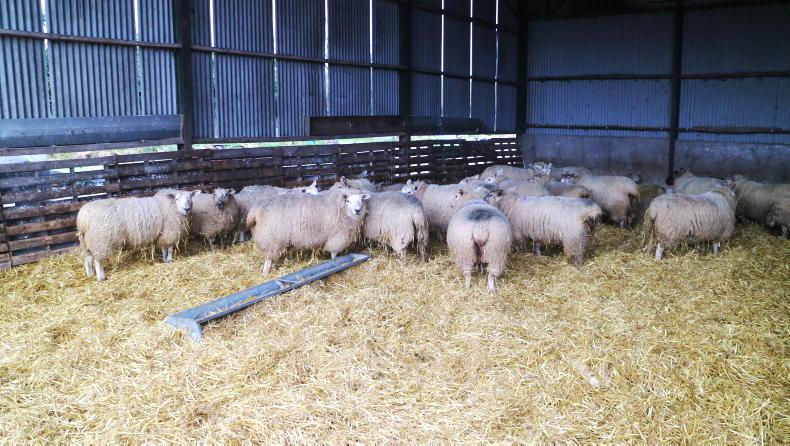
Yearling hoggets lamb in April which suits labour availability and also enhances output.
John’s preference is to get calves on farm and settled, ideally in the first three weeks of March and at the latest by the end of the month.
The reasoning is multifactorial and includes labour increasing in April to cover lambing in the region of 70 yearling hoggets.
John is also a big advocate of purchasing earlier-born calves to achieve greater weight gain from grass in the first season and to keep the spread in ages to a minimum for ease of management.
The tillage crops planted on the farm are mainly winter barley and winter oats, with winter as opposed to spring crops balancing workload across the year.
John Fraser runs mixed sheep, dairy calf-to-beef and tillage enterprises on 60ha owned land and 40ha rented ground in Garrons, Co Laois.The focus on the farm is to interlink the sheep, beef and tillage enterprises to make best use of labour, land and facilities. Homegrown feed is converted to high-quality lamb and beef while nutrients are recycled to tillage lands. Animals are drafted at their most efficient stage of production for the farm, with dairy-beef animals drafted through Irish Hereford Prime and lambs sold to Kildare Chilling. The aim in the first half of 2022 is to ensure performance of livestock is maintained and sufficient silage is saved for next winter. Sheep system
Breeding in the ewe flock is built on a good balance of ewes which deliver a medium level of prolificacy and produce lambs with good terminal traits that are good converters of feed and achieve positive slaughter performance.
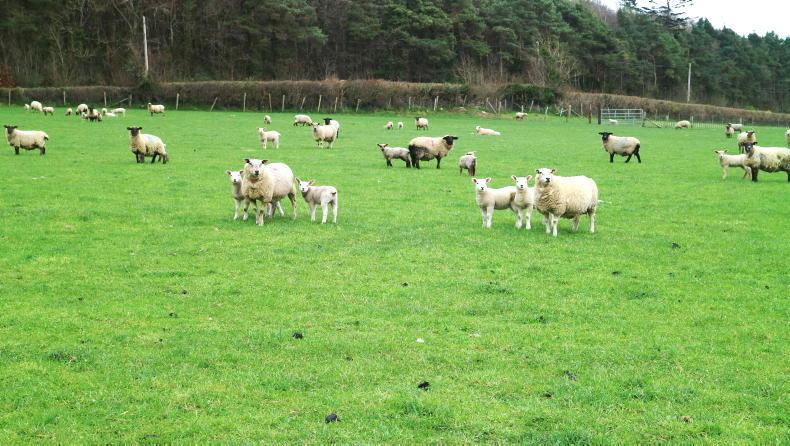
The ewe flock has now switched to a closed flock policy.
Background breeding in the flock is a mixture of Suffolk, Mule and Texel crosses, with these sheep purchased while numbers were building.
In recent years, John has switched to a closed flock policy and has been selecting replacements from Charollais sires with a good balance of terminal and maternal traits. He has also experimented in the most recent season with a Rouge de L’Ouest ram.
The scanning rate in the mature flock in the 2021-22 breeding year was 1.78 lambs, which is almost at the desired level.
“I am happy enough with it [scanning] and hopefully having full control now over what replacements I retain I can push it up a little to between 1.8 and 1.9 lambs. I could opt for more prolific genetics but the last situation I want in spring, when labour availability is at its highest, is to be dealing with a big number of triplets. I am happy with how lambs are performing and the drafting pattern and would be slow to jeopardise that too.”
The scanning rate in the yearling hoggets of 1.58 lambs per ewe mated is a positive signal that prolificacy in the flock is improving.
Ewe lambs are bred for a four-week period but the fact that replacements are selected from the mature ewe flock means these sheep are well fit for breeding and conception rates are high.
Homegrown concentrates
The late-pregnancy concentrate feeding programme is simple and is based on beet, homegrown oats and soya bean. Ewes are supplemented with beet at grass and then oats and soya bean are fed (including minerals) once ewes are housed in advance of lambing.
Triplets are housed around Christmas, twins in early January and singles are retained outdoors and are supplemented with beet until a few week pre-lambing.
John is very happy with beet as a feed for ewes but cautions that the transition from beet to an indoor diet can lead to issues if not handled carefully.
Beet is also fed depending on weather conditions and grass dry matter/utilisation post-lambing to deliver a nutritional boost.
Turnips were grown in the past to overwinter ewes and while these worked well, the fact that the field is out of production for a year has seen this practice discontinue.
It is a similar story with forage crops such as redstart and kale, with John experimenting with these in the past but finding that the area is out of production for too long and that it may possibly suit a later-lambing flock better where lambs can be finished on it.
He does, however, see big potential in livestock farmers joining forces with tillage farmers to graze cover crops, with his ewe lambs run on a neighbouring rape cover crop over the winter and coming off the crop in prime condition.
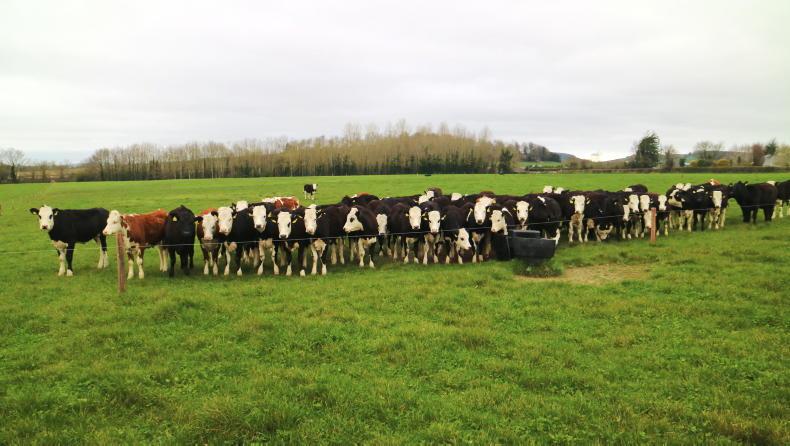
Animals are grazed in a rotational grazing system and moved to fresh grass every few days.
The volumes of meal fed are minimised by a firm focus on making top-quality silage on the farm. Silage quality is excellent, with the DMD ranging from 74.8 to 83.4, while crude protein levels range from 17.6% to 20.6%. This is also integral to finishing cattle efficiently as will be discussed later.
The foundation of creep fed to lambs is homegrown grain.
A lamb starter is used to get lambs accustomed to eating creep and gradually transitions to a barley-based feed with a few straight ingredients added in along with minerals to balance the feed.
Lambs are typically weaned at 13 to 14 weeks of age.
Weaning at this stage greatly reduces grass demand following ground being closed for silage.
Once lambs approach slaughter, weighing and drafting takes place regularly to allow lambs get as close to 20kg carcase weight as possible, while avoiding lambs going overweight and ending up giving free meat away that has been a significant cost to produce.
Grassland management
and grazing infrastructureRotational grazing is practised across all areas of the farm, with different grazing groups assigned to various areas of the farm.
Ewes and lambs graze silage ground early in the season and then enter a grazing group with calves.
Lambs and calves are offered the best-quality grass during the months from April through to August with ewes following and used to graze out paddocks and deliver high-quality regrowth.
Surplus grass is also saved as high-quality bales and fed in late pregnancy or to cattle for finishing.
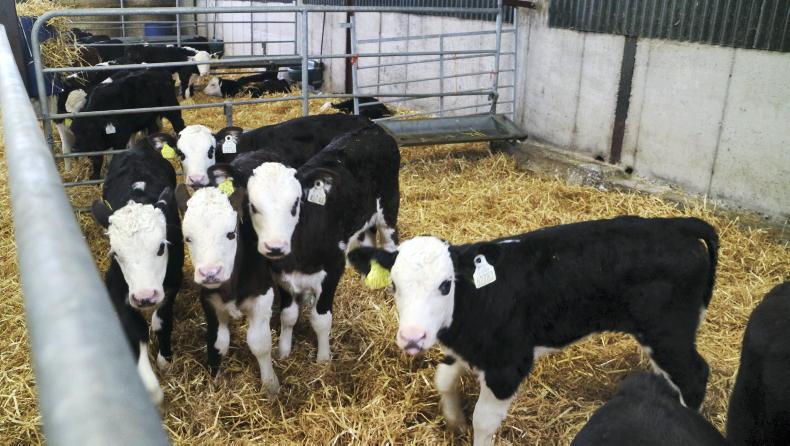
Calves are usually split into a number of groups based on age and size and this allows for preferential treatment, if required. They are turned outdoors as soon as possible with John experimenting, with a homemade mobile milk feeder to allow turnout take place even earlier this year.
Weaning of calves was pushed back by two weeks in 2021 due to harsh weather and poor grass growth in May. The hope is to get this back to 10 weeks in 2022 and get more gain from grass. Calves are performing well and look well on target.
Growth slowing
Yearling cattle are typically grazed on the own. They graze earlier in the year in an outfarm block and move to aftergrass swards as the season progresses, with growth usually slowing due to a low soil moisture content.
Meal feeding continues in summer at a rate of 1kg per head daily and John finds it delivers a benefit in underpinning performance. The feeding rate may be reviewed in 2022 due to the cost of concentrates but unless the economics are hugely challenging, the practice will continue.
The farm purchased its normal fertiliser requirement for the first half of the year.
“It is hard to comprehend the cost of it but if we don’t put it out we will be in a much worse position. For now, I am concentrating on keeping the performance of stock on track and ensuring we grow enough silage for next winter.”
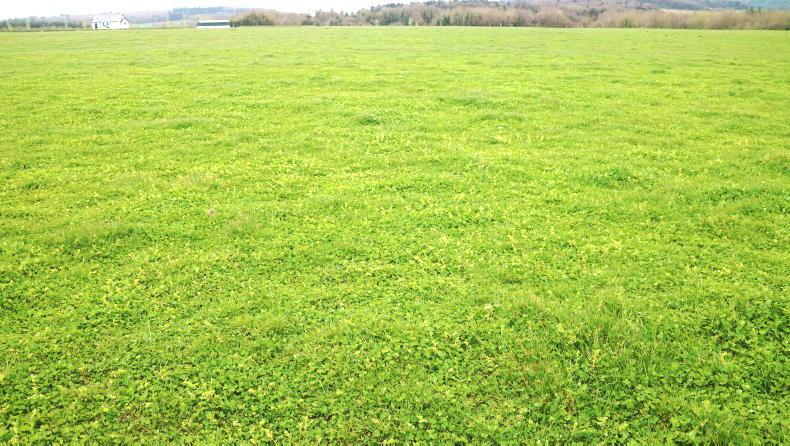
A sward with a good content of white clover. These swards will be asked to work harder in 2022 in light of escalating input costs.
White clover has been incorporated into swards reseeded in recent years and John is hoping he can utilise this more in 2022 to reduce the requirements for applied nitrogen as the season progresses.
He has also submitted an application for the Multi Species Sward Measure and the Red Clover Measure and will look to assess the merits of these. The aim at present is to stitch in the seed to reduce establishment costs and get ground back in to the grazing rotation quicker.
Dairy calf-to-beef enterpriseThe cattle enterprise can be split into about 70% bullocks and 30% heifers, with the preference for Hereford crosses.
Heifers are purchased first, if possible, as the aim is to get these finished at 18 to 20 months of age off grass. As yearlings, heifers are prioritised for early turnout, with this year’s batch going to grass at the start of March.
The level of supplementation pre-slaughter is usually dictated by grass supplies and grass quality. The volume of meal fed to heifers finished in September and October 2021 averaged at 168kg.
Stock are marketed through the Irish Hereford Prime producer group. Heifers achieved an average carcase weight of 260kg in 2021 and graded O=/O+, meaning all animals satisfied the required specification (240kg to 380kg carcase weight and grading O= or better) to secure breed bonus payments.
Bullocks
Bullocks are also drafted for slaughter and marketed through Irish Hereford Prime as they come fit from January through to March as 22 to 24 months of age.
This year’s bullocks consumed 384kg meal (homegrown barley-based), two tonnes of beet and two tonnes of silage per head and recorded an average carcase weight of 361kg. Grading in the bullocks was helped by a longer period of feeding pre-slaughter compared to the heifers and included 26 animals grading O=/O+ and 19 grading R.
Straw bedding is used in all sheds, including the main finishing shed, where slats are located along the feeding passage and animals then access a straw-bedded lie-back area.
Straw is recycled back on to tillage ground to enhance organic matter.
Barley and oats are the main crops sown, with wheat also sown to adhere to the three-crop rule.
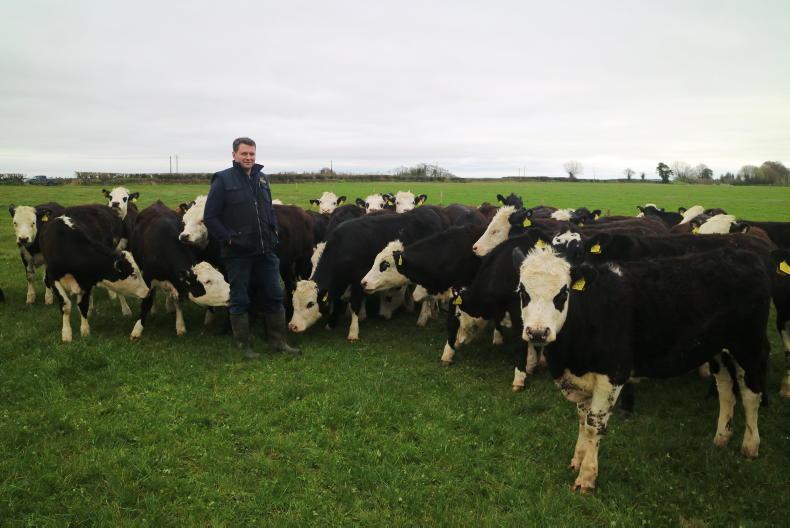
John Fraser with yearling Hereford heifers which were turned outdoors in early March.
The farm is busy but the different enterprises combine to good effect to utilise labour and facilities. Another significant benefit of the different production systems and numerous sale dates across the year is a more balanced cashflow.
The increasing reliance of Irish livestock enterprises on imported feed was attracting more attention long before the recent escalation in concentrate costs and concerns surrounding feed availability.
New initiatives introduced by the Department of Agriculture via the Tillage Incentive Scheme, multispecies/red clover sward measures and tweaks to the Protein Aid Scheme are aimed at increasing the volume of fodder grown on farms this season.
John Fraser’s farm in Garrons, a short distance outside Stradbally in Co Laois, has been striving in recent years to develop a more holistic system where the enterprises of beef, sheep and tillage deliver mutual benefits.
The farm was traditionally predominately tillage, along with finishing some continental cattle.
However, since taking over the running of the farm, John has developed a sheep enterprise which has grown to in excess of 300 head and a dairy calf-to-beef enterprise, which now numbers 90 to 100 head.
Self-sufficiency focus
The focus on the farm is to drive production where at all possible from feed grown on the farm or in close proximity in the case of the purchase of fodder beet and grazing of catch crops grown by neighbouring farmers.
The livestock enterprises also have to dovetail with each other in terms of making best use of available facilities.
The flock of 250 mature ewes are mated to lamb in a tight three- to four-week timeframe in February. Once ewes vacate straw-bedded sheds they are cleaned, washed and disinfected in advance of calves being purchased in March.

Yearling hoggets lamb in April which suits labour availability and also enhances output.
John’s preference is to get calves on farm and settled, ideally in the first three weeks of March and at the latest by the end of the month.
The reasoning is multifactorial and includes labour increasing in April to cover lambing in the region of 70 yearling hoggets.
John is also a big advocate of purchasing earlier-born calves to achieve greater weight gain from grass in the first season and to keep the spread in ages to a minimum for ease of management.
The tillage crops planted on the farm are mainly winter barley and winter oats, with winter as opposed to spring crops balancing workload across the year.
John Fraser runs mixed sheep, dairy calf-to-beef and tillage enterprises on 60ha owned land and 40ha rented ground in Garrons, Co Laois.The focus on the farm is to interlink the sheep, beef and tillage enterprises to make best use of labour, land and facilities. Homegrown feed is converted to high-quality lamb and beef while nutrients are recycled to tillage lands. Animals are drafted at their most efficient stage of production for the farm, with dairy-beef animals drafted through Irish Hereford Prime and lambs sold to Kildare Chilling. The aim in the first half of 2022 is to ensure performance of livestock is maintained and sufficient silage is saved for next winter. Sheep system
Breeding in the ewe flock is built on a good balance of ewes which deliver a medium level of prolificacy and produce lambs with good terminal traits that are good converters of feed and achieve positive slaughter performance.

The ewe flock has now switched to a closed flock policy.
Background breeding in the flock is a mixture of Suffolk, Mule and Texel crosses, with these sheep purchased while numbers were building.
In recent years, John has switched to a closed flock policy and has been selecting replacements from Charollais sires with a good balance of terminal and maternal traits. He has also experimented in the most recent season with a Rouge de L’Ouest ram.
The scanning rate in the mature flock in the 2021-22 breeding year was 1.78 lambs, which is almost at the desired level.
“I am happy enough with it [scanning] and hopefully having full control now over what replacements I retain I can push it up a little to between 1.8 and 1.9 lambs. I could opt for more prolific genetics but the last situation I want in spring, when labour availability is at its highest, is to be dealing with a big number of triplets. I am happy with how lambs are performing and the drafting pattern and would be slow to jeopardise that too.”
The scanning rate in the yearling hoggets of 1.58 lambs per ewe mated is a positive signal that prolificacy in the flock is improving.
Ewe lambs are bred for a four-week period but the fact that replacements are selected from the mature ewe flock means these sheep are well fit for breeding and conception rates are high.
Homegrown concentrates
The late-pregnancy concentrate feeding programme is simple and is based on beet, homegrown oats and soya bean. Ewes are supplemented with beet at grass and then oats and soya bean are fed (including minerals) once ewes are housed in advance of lambing.
Triplets are housed around Christmas, twins in early January and singles are retained outdoors and are supplemented with beet until a few week pre-lambing.
John is very happy with beet as a feed for ewes but cautions that the transition from beet to an indoor diet can lead to issues if not handled carefully.
Beet is also fed depending on weather conditions and grass dry matter/utilisation post-lambing to deliver a nutritional boost.
Turnips were grown in the past to overwinter ewes and while these worked well, the fact that the field is out of production for a year has seen this practice discontinue.
It is a similar story with forage crops such as redstart and kale, with John experimenting with these in the past but finding that the area is out of production for too long and that it may possibly suit a later-lambing flock better where lambs can be finished on it.
He does, however, see big potential in livestock farmers joining forces with tillage farmers to graze cover crops, with his ewe lambs run on a neighbouring rape cover crop over the winter and coming off the crop in prime condition.

Animals are grazed in a rotational grazing system and moved to fresh grass every few days.
The volumes of meal fed are minimised by a firm focus on making top-quality silage on the farm. Silage quality is excellent, with the DMD ranging from 74.8 to 83.4, while crude protein levels range from 17.6% to 20.6%. This is also integral to finishing cattle efficiently as will be discussed later.
The foundation of creep fed to lambs is homegrown grain.
A lamb starter is used to get lambs accustomed to eating creep and gradually transitions to a barley-based feed with a few straight ingredients added in along with minerals to balance the feed.
Lambs are typically weaned at 13 to 14 weeks of age.
Weaning at this stage greatly reduces grass demand following ground being closed for silage.
Once lambs approach slaughter, weighing and drafting takes place regularly to allow lambs get as close to 20kg carcase weight as possible, while avoiding lambs going overweight and ending up giving free meat away that has been a significant cost to produce.
Grassland management
and grazing infrastructure
Rotational grazing is practised across all areas of the farm, with different grazing groups assigned to various areas of the farm.
Ewes and lambs graze silage ground early in the season and then enter a grazing group with calves.
Lambs and calves are offered the best-quality grass during the months from April through to August with ewes following and used to graze out paddocks and deliver high-quality regrowth.
Surplus grass is also saved as high-quality bales and fed in late pregnancy or to cattle for finishing.

Calves are usually split into a number of groups based on age and size and this allows for preferential treatment, if required. They are turned outdoors as soon as possible with John experimenting, with a homemade mobile milk feeder to allow turnout take place even earlier this year.
Weaning of calves was pushed back by two weeks in 2021 due to harsh weather and poor grass growth in May. The hope is to get this back to 10 weeks in 2022 and get more gain from grass. Calves are performing well and look well on target.
Growth slowing
Yearling cattle are typically grazed on the own. They graze earlier in the year in an outfarm block and move to aftergrass swards as the season progresses, with growth usually slowing due to a low soil moisture content.
Meal feeding continues in summer at a rate of 1kg per head daily and John finds it delivers a benefit in underpinning performance. The feeding rate may be reviewed in 2022 due to the cost of concentrates but unless the economics are hugely challenging, the practice will continue.
The farm purchased its normal fertiliser requirement for the first half of the year.
“It is hard to comprehend the cost of it but if we don’t put it out we will be in a much worse position. For now, I am concentrating on keeping the performance of stock on track and ensuring we grow enough silage for next winter.”

A sward with a good content of white clover. These swards will be asked to work harder in 2022 in light of escalating input costs.
White clover has been incorporated into swards reseeded in recent years and John is hoping he can utilise this more in 2022 to reduce the requirements for applied nitrogen as the season progresses.
He has also submitted an application for the Multi Species Sward Measure and the Red Clover Measure and will look to assess the merits of these. The aim at present is to stitch in the seed to reduce establishment costs and get ground back in to the grazing rotation quicker.
Dairy calf-to-beef enterpriseThe cattle enterprise can be split into about 70% bullocks and 30% heifers, with the preference for Hereford crosses.
Heifers are purchased first, if possible, as the aim is to get these finished at 18 to 20 months of age off grass. As yearlings, heifers are prioritised for early turnout, with this year’s batch going to grass at the start of March.
The level of supplementation pre-slaughter is usually dictated by grass supplies and grass quality. The volume of meal fed to heifers finished in September and October 2021 averaged at 168kg.
Stock are marketed through the Irish Hereford Prime producer group. Heifers achieved an average carcase weight of 260kg in 2021 and graded O=/O+, meaning all animals satisfied the required specification (240kg to 380kg carcase weight and grading O= or better) to secure breed bonus payments.
Bullocks
Bullocks are also drafted for slaughter and marketed through Irish Hereford Prime as they come fit from January through to March as 22 to 24 months of age.
This year’s bullocks consumed 384kg meal (homegrown barley-based), two tonnes of beet and two tonnes of silage per head and recorded an average carcase weight of 361kg. Grading in the bullocks was helped by a longer period of feeding pre-slaughter compared to the heifers and included 26 animals grading O=/O+ and 19 grading R.
Straw bedding is used in all sheds, including the main finishing shed, where slats are located along the feeding passage and animals then access a straw-bedded lie-back area.
Straw is recycled back on to tillage ground to enhance organic matter.
Barley and oats are the main crops sown, with wheat also sown to adhere to the three-crop rule.

John Fraser with yearling Hereford heifers which were turned outdoors in early March.
The farm is busy but the different enterprises combine to good effect to utilise labour and facilities. Another significant benefit of the different production systems and numerous sale dates across the year is a more balanced cashflow.













 This is a subscriber-only article
This is a subscriber-only article









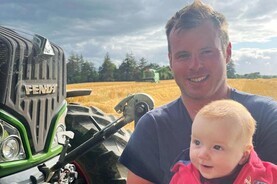
SHARING OPTIONS: